Instructions for Side by Side Printing
- Print the notecards
- Fold each page in half along the solid vertical line
- Cut out the notecards by cutting along each horizontal dotted line
- Optional: Glue, tape or staple the ends of each notecard together
Mesopotamia and Egypt Test, AP Art History
front 1 White Temple and its Ziggurat Artist/Culture | back 1 Sumerian |
front 2 Statues of Votive Figures (from the Square Temple at Eshnunna) Artist/Culture | back 2 Sumerian |
front 3 Standard of Ur (from the Royal Tombs at Ur) Artist/Culture | back 3 Sumerian |
front 4 Code of Hammurabi Artist/Culture | back 4 Babylonian |
front 5 Lamassu (from the citadel of Sargon II) Artist/Culture | back 5 (Neo-)Assyrian |
front 6 Audience Hall (apadana) (of Darius and Xerxes) Artist/Culture | back 6 Persian |
front 7 animism | back 7 belief that gods/spirits are embedded in nature, and that they control nature |
front 8 apadana | back 8 audience hall in Persian palace |
front 9 apotropaic | back 9 believed to have the power to ward off danger, evil, or bad luck |
front 10 bent-axis | back 10 a pathway through or up a building that is not straight or direct, but takes a bent or angled path instead |
front 11 buttress | back 11 a support of stone or brick built against a wall |
front 12 citadel | back 12 fortress protecting a town |
front 13 cuneiform | back 13 wedge-shaped system of writing created by Sumerians |
front 14 facade | back 14 front of building |
front 15 floor plan/ground plan | back 15 bird's eye map of building |
front 16 hierarchy of scale/hierarchical perspective | back 16 a person's importance relates to his size relative to others in an artwork |
front 17 hybrid | back 17 two or more different things joined together (usually animal forms) |
front 18 hypostyle hall | back 18 a hall with a roof supported by multiple columns |
front 19 lamassu | back 19 Assyrian winged human-headed bull; guardians |
front 20 register | back 20 a horizontal level of artwork that is delineated from other levels |
front 21 votive offering | back 21 a gift of gratitude to a deity |
front 22 ziggurat | back 22 pyramid-like building whose stories indent as building progresses upwards |
front 23  | back 23 White Temple and its Ziggurat |
front 24  | back 24 Statues of Votive Figures (from the Square Temple at Eshnunna) |
front 25 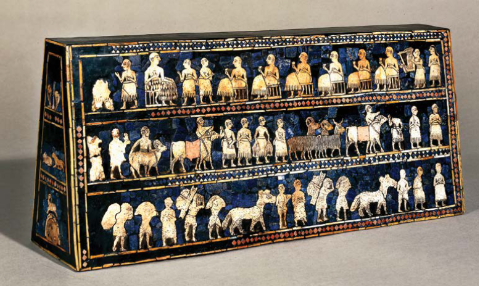 | back 25 Standard of Ur from the Royal Tombs at Ur |
front 26  | back 26 Code of Hammurabi |
front 27 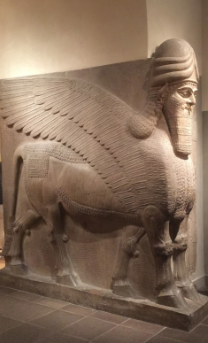 | back 27 Lammasu from the citadel of Sargon II |
front 28 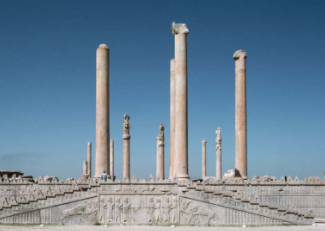 | back 28 Audience Hall (apadana) of Darius and Xerxes |
front 29 White Temple and its Ziggurat Medium | back 29 Mud brick |
front 30 Statues of Votive Figures Medium | back 30 Gypsum inlaid with shell, lapis lazuli, and red limestone |
front 31 Standard of Ur Medium | back 31 Wood inlaid with shell, lapis lazuli, and red limestone |
front 32 Code of Hammurabi Medium | back 32 Basalt |
front 33 Lamassu from the citadel of Sargon II Medium | back 33 Alabaster |
front 34 Audience Hall (apadana) of Darius and Xerxes Medium | back 34 Limestone |
front 35 White Temple and its Ziggurat Location | back 35 Uruk, Iraq |
front 36 States of Votive Figures Location | back 36 Tell Asmar, Iraq |
front 37 Standard of Ur Location | back 37 Tell el-Muqayyar, Iraq |
front 38 Code of Hammurabi Location | back 38 Babylon (modern day Susa, Iran) |
front 39 Lamassu from the citadel of Sargon II Location | back 39 Dur-Sharrukin, Iraq |
front 40 Audience Hall (apadana) of Darius and Xerxes | back 40 Persepolis, Iran |
front 41 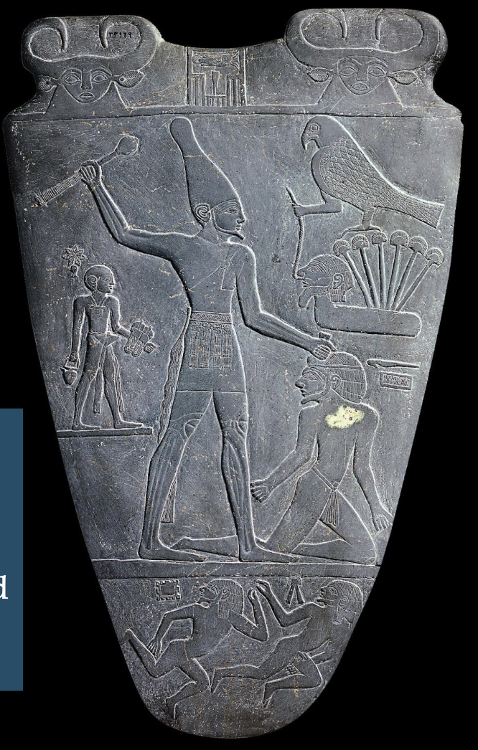 | back 41 Palette of King Narmer |
front 42 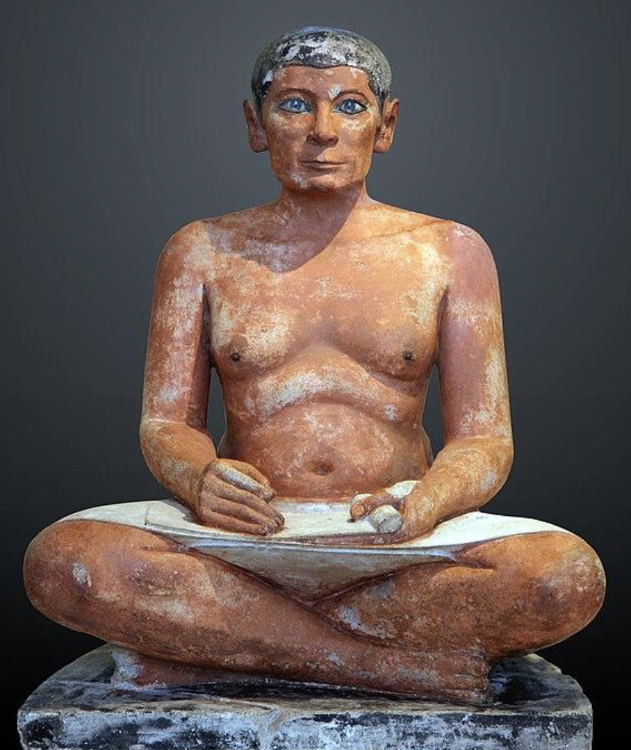 | back 42 Seated Scribe |
front 43 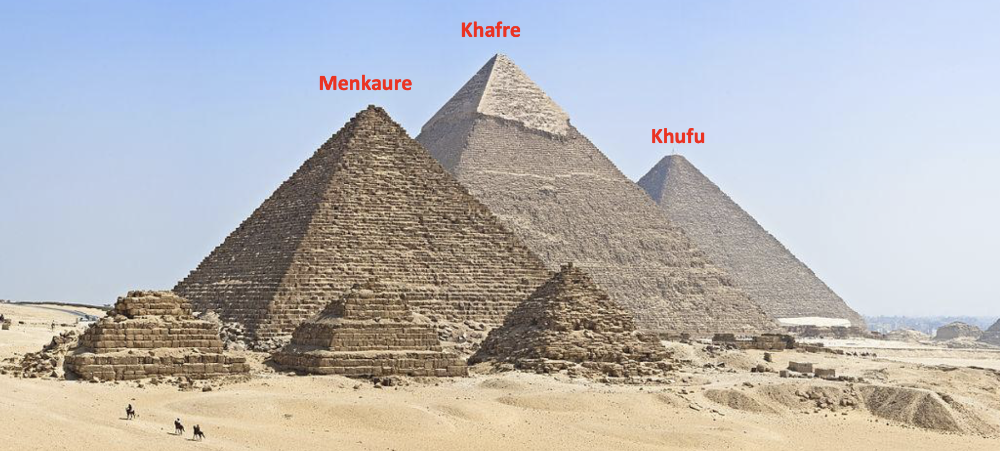 | back 43 Great Pyramids (Menkaure, Khafre, Khufu) |
front 44 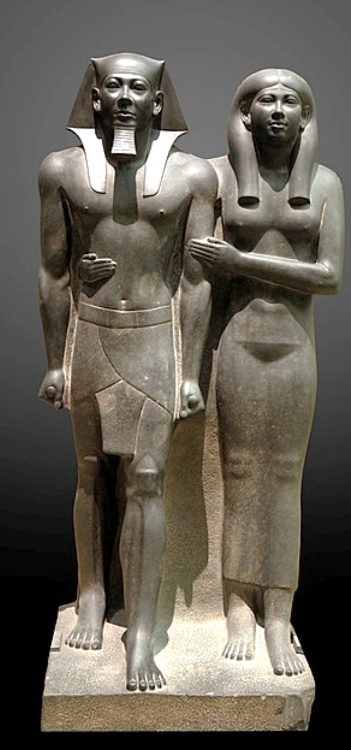 | back 44 King Menkaure and Queen |
front 45  | back 45 Great Sphinx (goes with Khafre pyramid) |
front 46 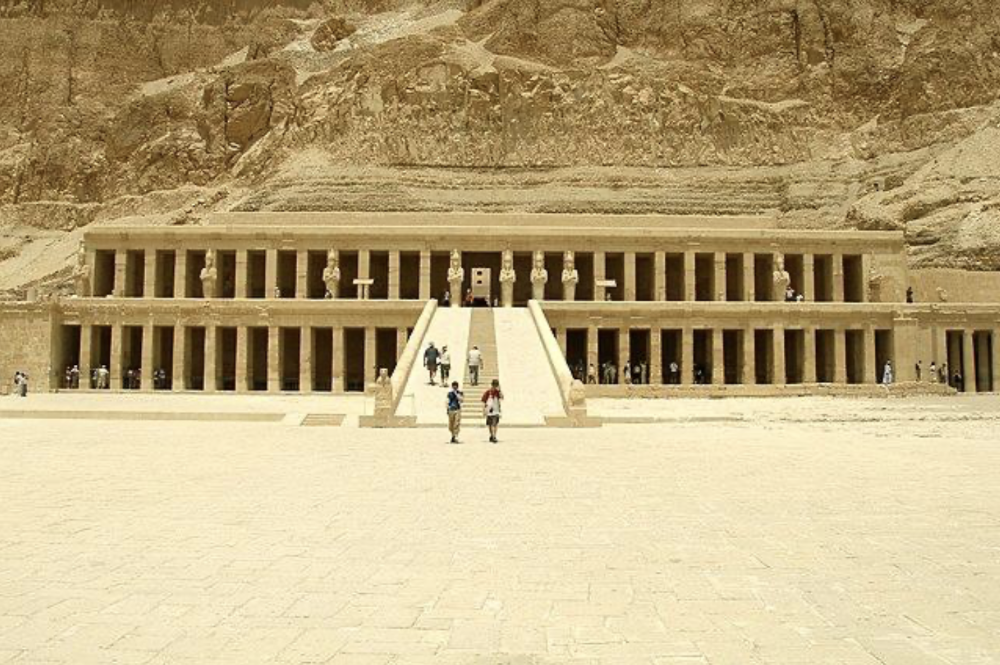 | back 46 Mortuary Temple of Hatshepsut |
front 47 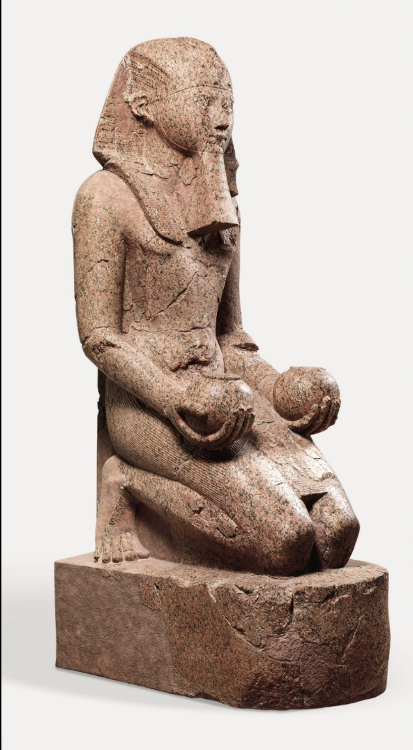 | back 47 Kneeling Statue of Hatshepsut |
front 48  | back 48 Temple of Amun-Re and Hypostyle Hall |
front 49 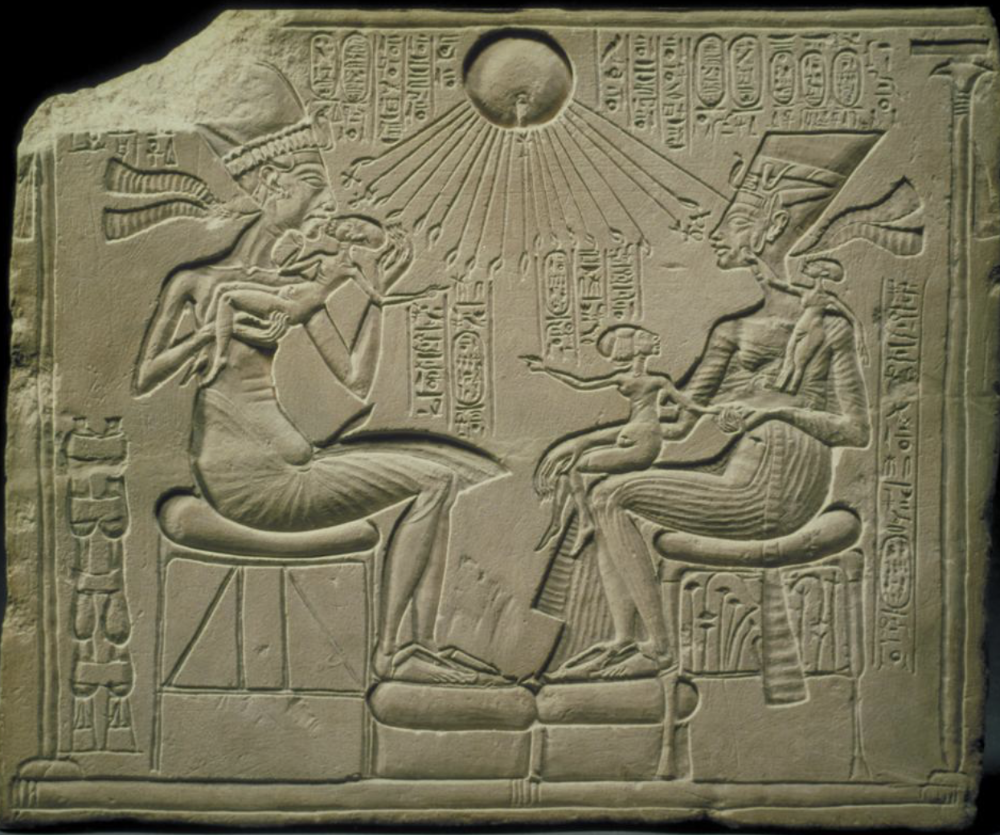 | back 49 Akhenaton, Nefertiti, and three daughters |
front 50 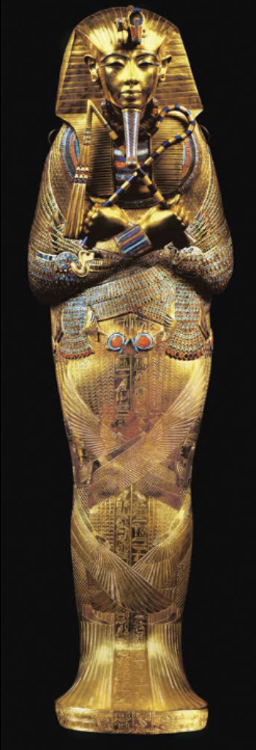 | back 50 Tutankhamun's tomb (innermost coffin) |
front 51  | back 51 Last Judgement of Hu-Nefer |
front 52 amarna style | back 52 an artistic style during the Amarna Period – Akhenaton’s rule – where traditional Egyptian conventions were abandoned for a more expressive and non-idealized style of art |
front 53 ankh | back 53 an Egyptian symbol of life |
front 54 axial plan | back 54 a building with an elongated floor plan |
front 55 canon of proportion | back 55 a system of measurement by which artists can regulate size, scale, and |
front 56 capital | back 56 top of a column |
front 57 clerestory | back 57 a roof that rises above lower roofs and thus has window space beneath that lets in light |
front 58 colonnade | back 58 a long sequence of columns joined by their entablature |
front 59 continuous narrative | back 59 an image that illustrates multiple scenes in a single frame;
therefore, some |
front 60 corridor axis | back 60 a long hallway or path enclosed by large stone masonry, possibly symbolized the Nile |
front 61 enamel | back 61 melted and fused glass powder mixed with pigment to create color; very smooth once cooled |
front 62 historical narrative | back 62 a story or sequence of events that is (or purports to be) historically accurate |
front 63 in situ | back 63 on site and in its original place |
front 64 ka | back 64 soul embedded in fleshly body, but upon death could live on; for the ___ to live securely, the dead body had to remain as intact as possible -> mummification developed |
front 65 living rock | back 65 rock that is not detached and is still in its original setting |
front 66 mastaba | back 66 simple tomb with four sloping sides which covers an underground burial chamber |
front 67 narrative | back 67 artwork that conveys a story, either as an ongoing story or as a sequence of events |
front 68 necropolis | back 68 greek for “city of the dead”; a complex of funerary buildings and tombs |
front 69 negative space | back 69 empty space around an object or person, such as the cut-out areas between a figure’s legs or arms of a sculpture |
front 70 papyrus | back 70 paper-like material prepared in ancient Egypt from Nile plants |
front 71 portico | back 71 a shallow columned porch |
front 72 pylon | back 72 the simple and massive gateway, with sloping walls, of an Egyptian temple |
front 73 relief sculpture | back 73 figures project from a background of which they are a part degree designated by 1) high; 2) low (bas); or 3) sunken/incised in the last, the artist cuts the design into the surface so that the highest projecting parts of the image are no higher than the surface itself |
front 74 sphinx | back 74 hybrid animal, with body of lion and head of Pharaoh/god that exhibits protective qualities |
front 75 subtractive | back 75 a sculptural process including the removal of material of a block through cutting, chiseling, chipping, or scraping away |
front 76 sunken relief | back 76 a type of relief carving where all lines are made into the surface, so that the design is set into the material |
front 77 Palette of King Narmer Artist/Culture | back 77 Predynastic Egypt |
front 78 Seated Scribe Artist/Culture | back 78 Egyptian Old Kingdom |
front 79 Great Pyramids Artist/Culture | back 79 Egyptian Old Kingdom |
front 80 King Menkaure and Queen Artist and Culture | back 80 Egyptian Old Kingdom |
front 81 Temple of Amun-Re and Hypostyle Hall Artist and Culture | back 81 Egyptian New Kingdom |
front 82 Mortuary temple of Hatshepsut & Kneeling Statue of Hatshepsut Artist and Culture | back 82 Egyptian New Kingdom |
front 83 Akhenaton, Nefertiti, and three daughters Artist and Culture | back 83 Egyptian New Kingdom (Amarna) |
front 84 Tutankhamun’s tomb (innermost coffin) Artist and Culture | back 84 Egyptian New Kingdom |
front 85 Last Judgment of Hu-Nefer Artist and Culture | back 85 Egyptian New Kingdom |
front 86 Palette of King Narmer Medium | back 86 Greywacke |
front 87 Seated Scribe Medium | back 87 painted limestone |
front 88 Great Pyramids Medium | back 88 cut limestone |
front 89 King Menkaure and Queen Medium | back 89 greywacke |
front 90 Temple of Amun-Re and Hypostyle Hall Medium | back 90 cut sandstone and mud brick |
front 91 Mortuary temple of Hatshepsut & kneeling statue of Hatshepsut Medium | back 91 sandstone partially carved into a rock cliff, and red granite |
front 92 Akhenaton, Nefertiti, and three daughters Medium | back 92 limestone |
front 93 Tutankhamun's tomb, innermost coffin Medium | back 93 gold with inlay of enamel and semiprecious stones |
front 94 Last Judgement of Hu-Nefer Medium | back 94 painted papyrus scroll |
front 95 Seated Scribe Location | back 95 Saqqara, Egypt |
front 96 Great Pyramids and Sphinx Location | back 96 Giza, Egypt |
front 97 Temple of Amun-Re and Hypostyle Hall Location | back 97 Karnak, near Luxor, Egypt |
front 98 Mortuary Temple of Hatshepsut Location | back 98 Near Luxor, Egypt |
front 99 Last Judgement of Hu-Nefer Location | back 99 Book of the Dead |